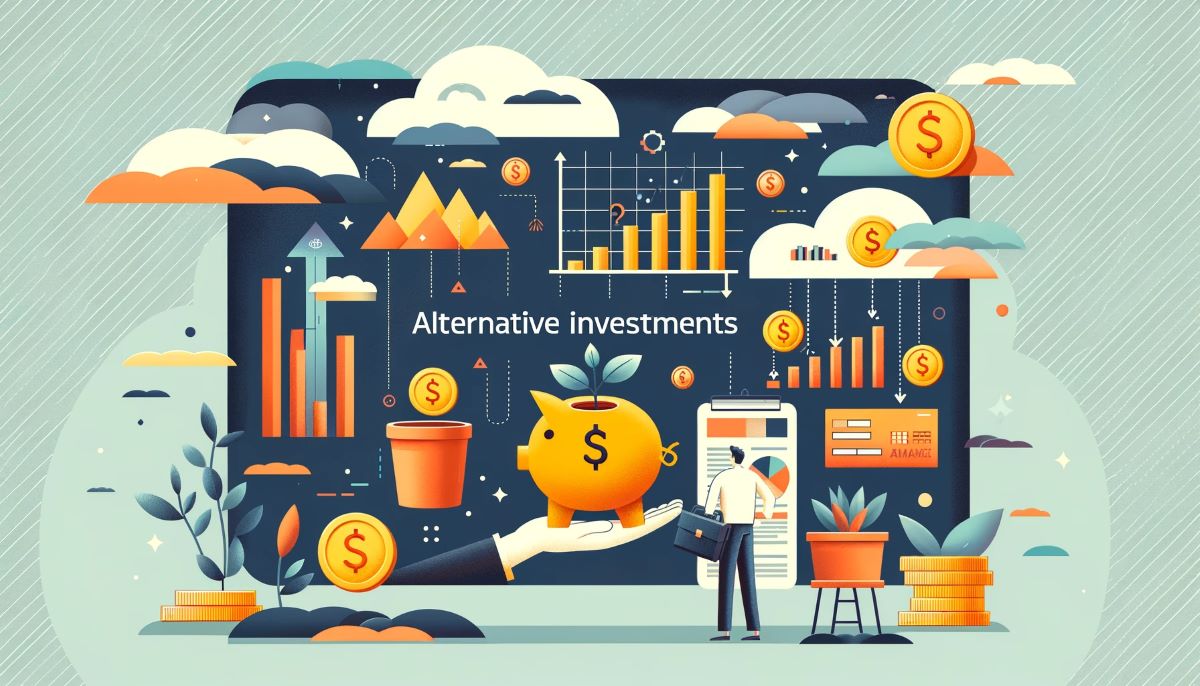What Are Alternative Investments?
Alternative investments can most simply be defined as investments that are made in asset classes outside of stocks and bonds. How many other asset classes are there? It turns out, quite a lot.
As you will see in this article, alternatives have unique characteristics, interesting potential benefits, important differences, and sometimes difficult trade-offs. They can be useful tools in constructing a highly diversified portfolio for the right investors.
Examples Of Alternative Investments
Real Estate

In order to function, modern society requires structures. We need places to live, locations to shop, warehouses to store goods, venues to host events, and garages to park our cars, just to name a few. Those structures all provide valuable services, which also means people often pay for those services as a course of basic life or doing business.
Investing in real estate looks to capitalize on that. Investments can generally be broken down into residential and commercial property types. Residential real estate would be properties like single family houses. Commercial real estate could include a wide variety of buildings including retail space used for grocery stores, warehouses used for ecommerce fulfillment centers, hotels, and event venues used for weddings.
Startups And Private Equity

Today, private companies can raise billions of dollars in funding and reach multi-deca-billion valuations before ever reaching the public markets. An extreme example of this trend is Uber. According to data from PitchBook, the company raised over $20B from venture capital and debt markets before their IPO.
At the time of this writing, that amount would rank in the top 360 most valuable companies by market capitalization. That’s in the same ballpark as recognizable companies like Southwest Airlines, McCormick, Clorox, Best Buy, Pinterest, and Formula One Group.
Uber rode that funding to what was considered to be a disappointing IPO, valuing the company at just over $75B. In addition to late-stage companies that go public, many startups are acquired by larger rivals before that happens. This was the case for Figma, which Adobe agreed to purchase for $20B.
Investing in startups provides investors with an extremely high risk, but potentially high-reward opportunity. The companies are smaller, younger, and less proven. That makes them much more likely to fail (which potentially brings the value of the investment to $0). However, it also offers the opportunity for investors to capture a level of growth that is often not possible with investing in larger, public companies.
Music Royalties

The music industry is very complex. Something you may not realize is that many people in the industry – artists, songwriters, and publishers – make a lot of their money from royalties. These tiny bits of revenue are generated when music is used and consumed. For example, when you stream a song on Apple Music, an average of $0.01 of royalties are generated.
Music royalty investments allow you to be the recipient of a share of these payments. This is a yield-producing asset class that has a variety of bond-like characteristics. It’s something you don’t expect appreciation from. If anything, depreciation is more likely. As songs age they tend to be played less, that means they will earn less, and the right to collect future royalties less valuable. That having been said, music royalty assets that are purchased at a reasonable valuation can provide strong yields for decades.
Fine Wine And Spirits

If you’ve ever heard the expression “aged like a fine wine,” you may already understand this idea behind this asset class.
There are a variety of fine wines and premium spirits that are produced every year. They often come from well-known producers and score very high in critic’s reviews. For each year there is only a limited quantity that is produced. As time goes on, the amount of remaining bottles decreases as people drink them. While that supply is dwindling, the bottles that remain are aging and becoming more valuable to potential buyers.
An investment in fine wines or spirits is a chance to profit from these dynamics. A decreasing supply and an asset that gets better – and more valuable – with time. It’s an asset class that rewards good purchases and patience. Investors should be prepared for fees and costs though. Those bottles need to be stored in a secure facility that is climate controlled. And you may want some insurance for them as well.
Farmland

Technology and innovation have changed many things about our lives. One thing that has never changed, however, is that we all need to eat. Where does that food come from? How does it get produced? Regardless of your diet, agricultural land is typically involved to some degree.
The United States produces a wide range of different crop types. This includes staples like corn, soybeans, wheat, and rice. It also includes foods like apples, cashews, and potatoes. If you look at the list of agricultural produce grown in the US, you’ll likely find many things you eat on a regular basis. The production of these essential, literally life-supporting resources, relies on the use of productive agricultural land.
Farmland investments provide an opportunity to capitalize on powerful supply and demand dynamics. There is a limited supply of land and an increasing demand for food from population growth. Over a longer-term time horizon, land that can remain productive and has reliable access to key resources like water, can meaningfully appreciate. Depending on the type of crop and how the opportunity is structured, the investment can provide yield from a variety of sources as well.
Who Can Invest In Alternative Investments
Accredited Vs. Non-Accredited Investors
Both accredited investors and non-accredited investors can invest in alternatives. However, accredited investors are not subject to the same restrictions as those who are non-accredited. The main limitations that non-accredited investors have are:
There are some investment platforms that only allow accredited investors to make investments. These are typically “private placement” opportunities that are not qualified with the SEC.
Additionally, some platforms cater to both types of investors, but have exclusive opportunities for accredited investors.
Alternative investment opportunities available to non-accredited investors often fall under Regulation CF or Regulation A/A+. These regulatory frameworks limit the amount of money the unaccredited can invest in a 12-month period of time.
To calculate the limits for these offering types, investors need to determine whether their yearly income or net worth is higher. The limits are based on the higher of the two.
- Reg CF Offerings
- If that number is below $124K:
- The investment limit is 5% of your [net worth or yearly income]
- Everyone can invest at least $2,500
- If the number exceeds $124K:
- The limit rises to 10% of your [net worth or yearly income]
- If that number is below $124K:
- Reg A/A+ Offerings
- The limit is simply 10% of your [net worth or yearly income]
Pros And Cons Of Alternative Investments
Benefits
There are a few major benefits of making investments in alternative assets. We’ll cover the main 3 benefits in more detail below. Please note that there are also risks you may be unaccustomed to, which are covered in the next section.
Diversification
A common piece of advice for investing in the stock market is to diversify your portfolio. Investors can go about that in various ways:
- Buying shares of ETFs that track a broad collection of stocks like the S&P 500
- Constructing a stock portfolio consisting of companies and ETFs across many different economic sectors
- Balancing a stock portfolio with bond holdings
All three of these strategies provide diversification, but how much depends on the alternative you’re comparing against. Compared to putting 100% of your investable assets into the stock of a single company, the above strategies offer tons of diversification and will help to reduce risk. If the assumption is that the only investment option is stocks, these are great options.
If you simply invested in the stock market, how much diversification does that provide?
Possible Hedge Against Inflation
As many investors learned in 2022, a combination of elevated inflation and rising interest rates can put a huge dent into the value of risk assets like stocks. Since risk assets are, well, risky, investors use different strategies to try to mitigate their risk levels.
One of the most popular strategies for managing risk is called a “60/40” portfolio. Investors put only 60% of their invested assets into stocks with the other 40% going to fixed income investments like bonds. Unfortunately, that approach didn’t help much. At one point in late 2022, the 60/40 portfolio had its worst performance in 100 years. Other strategies struggled as well. A portfolio with an even mix of stocks, commodities, bonds, and cash would have seen its worst performance since 2008.
So what can investors do? One option might be to take a harder look at the alternative investment opportunities available to them.
One asset class that has historically performed well during periods of high inflation is farmland. According to research done by the TIAA Center for Farmland Research, farmland values have more than a 60% correlation to CPI and PPI. In some types of calculations, the correlation reaches nearly 76%.
So, how did farmland perform in 2022? According to the USDA, farmland values increased 12.4%, on average, across the United States. On top of that appreciation, most farmland investment opportunities provide some yield from farm rents.
Potential For Higher Returns
Every investment opportunity is unique, with its own merits and flaws. That having been said, alternative investments can offer potential for higher returns.
Sometimes there are just unique opportunities that aren’t available in public markets. One example of this would be investing in startups. In 2009, venture capitalists invested in Airbnb at $0.01/share. On the public market, shares of the company have mostly traded north of $100/share over the past 6 months.
Many alternative investments are longer term in nature and lock up capital for extended periods of time. In exchange for this tradeoff, these opportunities can have more time for a project or thesis to play out. The managers can focus on the long term goals without having to face the pressure to meet short-term performance targets that public companies often receive.
Risks And Drawbacks
While there are some exciting potential benefits to investing in alternatives, there are also some meaningful risks and drawbacks as well. Below, we’ll cover 4 that stand out as something investors should seriously consider.
Lack Of Liquidity
If you’ve only invested in public markets or cryptocurrencies so far, you’re likely taking liquidity for granted.
Liquidity, simply put, is the ability to quickly and easily buy or sell an investment. This allows you to access your invested capital if you ever want or need to. However, liquidity is not an inherent characteristic of investment. Most alternative investment opportunities have some weaknesses in this area.
For any opportunity an important question is – how do you exit? The options here usually broadly fit into one of these categories:
- A minimum holding period is met and there is a baked-in “early exit” plan for the investment.
- Trading on a secondary market. Some platforms have “secondary markets” which allow investors to buy and sell shares with each other, prior to the planned liquidity event occurring.
- The target liquidity event occurs. For example, a real estate investment might be held for 5 or 10 years before the property is sold off. Proceeds are then distributed to the investors and are free to be reinvested.
In the case of the first two, there is no guarantee that you can get the best price, or even a good price, for exiting early. The “early exit” plans that investment platforms offer may even penalize you in exchange for early liquidity. Even when secondary markets exist, the order books are relatively thin and investors are often trying to scoop assets up at a discount.
In the case of the latter, it offers the possibility of existing at the “best” price. However, it comes at the expense of locking up your principal investment for the longest period of time.
While it is somewhat of an unusual case, it is also possible for there to be no existing exit strategy. The assets being offered don’t have a target period of time where they will be liquidated. There is no “buy back” plan in place from the investment manager. And there is no secondary market. In these cases, the investment platforms typically “plan” to develop a secondary market, but without any guarantee that it will ever happen.
Higher Fees
Anyone accustomed to low-fee ETFs and $0 commission trading will have to come to grips with an unavoidable part of alternatives – fees. The types of fees can vary, but they are numerous. Here’s a few broad categories that you can expect to encounter:
- Asset under management fee. This is typically charged as a percentage of your account value.
- These fees do typically increase as the appraised values of your holding increase. At the end of the day, those appraisals are often the sole discretion of the investment manager.
- A sourcing fee or “finders fee.” The platform or company you’re making an investment with can charge a fee for bringing the opportunity to the platform.
- These fees are not always clearly presented either. You may have to read the offering circular and SEC filings to find the information.
- Performance fees or “carried interest.” These sometimes get discussed under different names, but the concept is always the same. Some portion of the returns above a certain threshold are “shared” with the investment company/platform/manager. For example, they may take 10% of any returns the investment generates above 5% IRR.
- These are often paired with asset under management (AUM) fees. You may see the terms “1 and 10” or “2 and 20.” That’s 1% AUM fee and 10% performance fee or 2% AUM fee and or 20% performance fee.
This is not an exhaustive list. Depending on the opportunity you may see more fees or different fee/expense structures such as revenue sharing.
Greater Level Of Risk
By their nature, some opportunities have a much higher level of risk. The best example of this is investing in startups.
Many businesses fail, and the companies appearing on equity crowdfunding websites are no exception. This means that there is a very realistic chance that the value of your shares could go to $0. It’s just a part of the asset class.
This even happens to all of the best and most well known venture capital companies. For example, Sequoia Capital, which has been around for decades, recently took a complete loss on their FTX investment.
Less Scrutiny Of Offerings
Public market opportunities require a variety of reports and disclosures. Since there are thousands (if not more) of firms trying to help pick the best investments for their clients, these companies receive a lot of scrutiny and analysis.
For example, Hindenburg Research has made headlines recently for their claims against the Adani Group. While we do not yet know for sure whether these claims are all true, there is a large amount of investigation and diligence that went into making that report. As a potential investor, you now have access to that report and can make your own decision about whether to invest or not.
The alternative asset space, particularly the part that is providing small, fractional opportunities to retail investors is small. Hindenburg Research is almost certainly never going to deep dive into a $250K fractional investment offering. That means there are generally less people scrutinizing these platforms and their offerings. It doesn’t mean that they are “scams” or that they are “not legit.” However, it does increase the odds of something like a platform providing an exploitive level of fees that can only be found in long, complicated offering documentation.
One thing investors can do to help mitigate this risk is to stick with offerings that have been qualified by the SEC. That means, at a minimum, the SEC has reviewed and approved the offering. It also means that you can find and review this documentation yourself. However, these offerings could still have issues like unreasonable risks and unfair fees, but at least the information about it is available for public scrutiny.
How To Access Alternative Investments
While investments in alternative assets can be made directly, most investors may prefer to get started with fractional approaches. The options available to you will vary based on the asset class.
With some searching, it is possible to find investment funds that are accepting new investors. In recent years, these have been somewhat common in the venture capital, private equity, and startup investing spaces. These typically have high minimum investments and may come with extra fees since someone is selecting investments on your behalf.
We expect that, for most of our readers, using an investment platform to purchase shares of offerings with low minimum investment sizes will be preferred. Just as fractional shares, lower- and no-commission fee stock trading made investing in the stock market more accessible, we are seeing a similar effort to democratize access within the alternatives space. There are lots of existing platforms and plenty of new ones being launched. Where to start your research really depends on the asset class you want to invest in.
Conclusion
Alternative investments are powerful portfolio construction tools. They can add uncorrelated returns, passive income, inflation protection, and greater upside to a portfolio. This can help with diversification and long-term returns.
However, alternative asset classes have their downsides as well. Liquidity is often poor at best and sometimes non-existent. That can leave investors waiting for a decade or longer to cash out on an investment decision. There are also a lot more fees and less eyes evaluating the legitimacy and value of these offerings. Some asset classes – like investing in startups – just inherently come with substantial risk of a loss of principal.
So, how should someone learn about these asset classes?
Where do you go to find out what’s happening in the industry?
What about figuring out where you can go to invest in something and how it works?
We’re doing our best to help with all that. At Asset Scholar, we are working to build a library of information about these asset classes, places to invest in them, and news around the industry. Take a look around to find out more! If you’d like to take a more passive approach, you can sign up for our newsletter. We’re sending a monthly summary of new articles available on the site.

